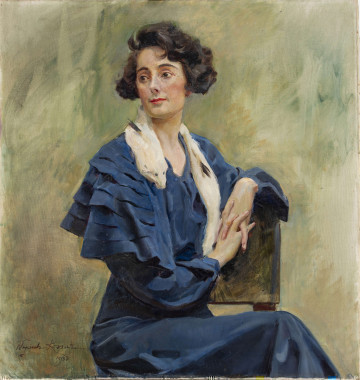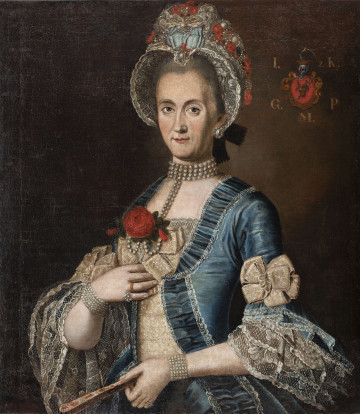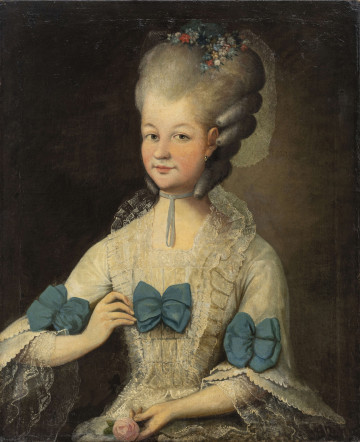
Portrait of Róża Duchowa
1933
National Museum in Lublin
Part of the collection: Portrait painting
The French Queen, Marie Antoinette, was enamoured with the tall extravagant hairstyles called pouffe, which were decorated in various ways. The powdered white wig was a graceful background for decorations with flowers, jewellery, ribbons and the like. These often had a symbolic meaning as they referred to specific events in the social or personal life of the wearer of the impressive wig. They were invented by the barber Leonard and the Queen's fashionista Rose Bertin.
The Queen's hairstyle was commented on and imitated. Fashionable dresses began to be sewn on the royal model from lighter and airier materials such as thin silks and muslins. The extravagance of the French in the field of fashion, dress and hairstyle was received with attention in other European countries in the 18th century. Not only aristocrats but also women of more modest positions imitated it. Polish women also drew on the French fashion stock. Many moralists held that against them, and many poets satirically described the uncritical rush for novelty.
Mrs. Chełmicka is depicted in just such a fashionable French outfit. Her high hairstyle is neither enormous nor adorned with anything more than a light muslin bonnet with a decorative bow. Nevertheless, a kind of cushion-headpiece wrapped around hair was used as a construction for the chignon to arrange the hair so fancifully. Natural hair could be enriched with different kinds of hairpieces, or with a complete wig. They were made of natural human hair, but less wealthy fashion slaves were content with horsehair. The Portrait of Chełmicka also shows her husband. The lady is portrayed fashionably, while the gentleman is in a traditional noblemen's robe and zhupan. The double portrait of the Chełmickis is almost an illustration for Ignacy Krasicki's satire The Fashionable Wife from 1779:
I was in bad spirits when I first saw me,
having already fallen in love and not wanting an abomination for a lady,
Rural Tyrsys, I sighed for my Filida...
Magdalena Norkowska
Author / creator
Dimensions
cały obiekt: height: 64 cm, width: 77 cm
Object type
painting
Technique
oil technique
Material
canvas, oil-based paint
Creation time / dating
Creation / finding place
Owner
The National Museum in Lublin
Identification number
Location / status

1933
National Museum in Lublin

1760 — 1780
National Museum in Lublin

1751 — 1800
National Museum in Lublin
DISCOVER this TOPIC
Castle Museum in Łańcut
DISCOVER this PATH
Educational path